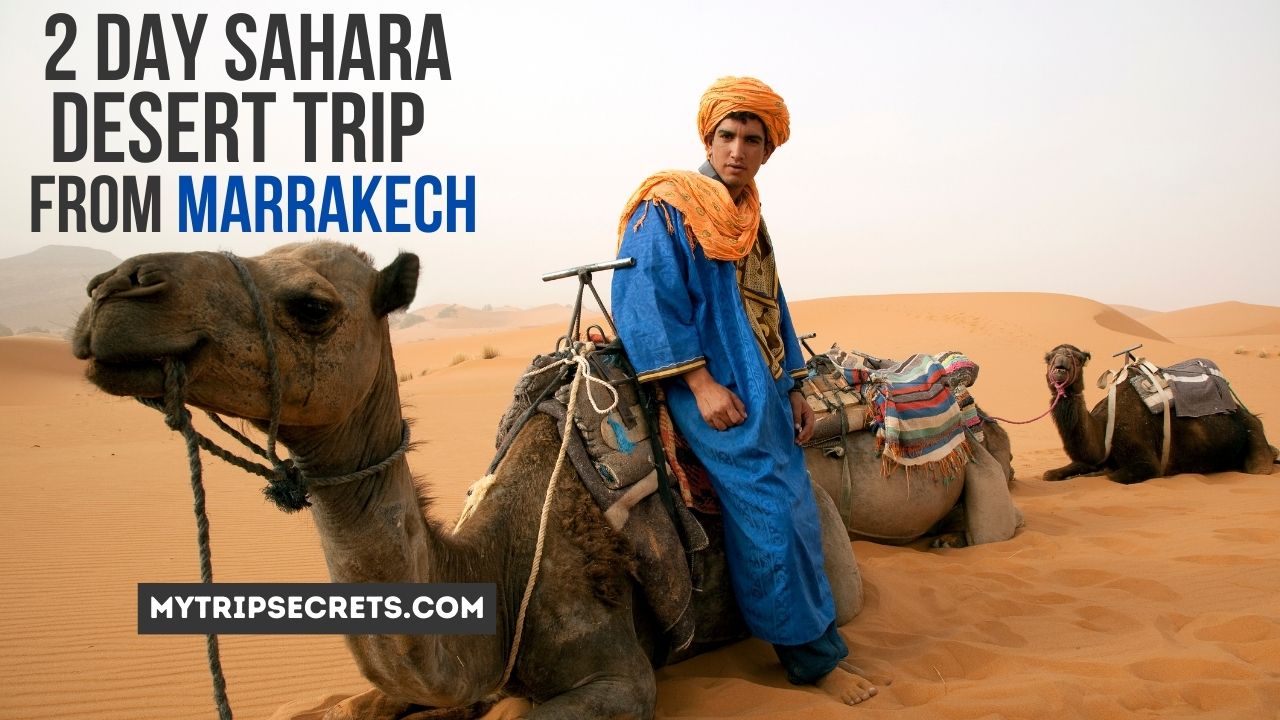Just a few hours drive outside the lively souks of Marrakech unfolds some of the world’s most captivating desert scenery – the vast golden dunes of the Sahara. While often associated with coastal gateways, adventures into the rolling sand seas actually work well on a 2 day Sahara desert trip from Marrakech. Thanks to the city’s central location and tourism infrastructure, Marrakech offers countless advantages for combining vibrant markets and riads with a short escape into Morocco’s rugged star-studded desert.
Whether seeking camel treks, traditional Berber villages or camping under endless constellations, a 2 day jaunt from Marrakech squeezes the Sahara’s highlights into an easy overnight getaway before returning renewed to the city.
Contents
2 Day Sahara Desert Trip from Marrakech 2024
Two day excursions to the Sahara desert from Marrakech generally follow a route southeast through typical Moroccan villages and over the High Atlas Mountains. Dropping down to the Sahara environs near Merzouga, travelers spend the night at a desert camp before returning to Marrakech.
What’s Included
Reputable 2 day desert tour operators provide necessities making the extremes of the Sahara manageable for travelers:
- 4×4 Landcruisers with air conditioning
- Berber guide
- Camel riding
- Overnight tented camp accommodation
- Bedding, linen, blankets
- Traditional Moroccan meals
- Bottled water
- Hotel pickup/drop-off
Why Visit the Sahara Desert from Marrakech
Many visitors naturally associate desert landscapes and activities with cities along Morocco’s western regions like Agadir. However, Marrakech conveniently connects travelers to the Sahara too while offering more flight options and attractions to combine with an epic desert adventure.
Adventurous Getaway from Marrakech
After absorbing the snake charmers, souks, gardens and palaces within vibrant Marrakech, travelers often yearn for a contrast. The harsh beauty and silence of endless Sahara dunes dotted only with date palm oases recharges the senses. The terrain challenges physically while amazing culturally.
Ideal Sahara Access Point
While not the geographically closest point, Marrakech sits much nearer to the authentic rolling dunes most imagine as stereotypical Sahara compared to spots further north. Expeditions reaching the heart of the desert near the Algerian border better start from Marrakech over other cities.
More Gateway Options
As an enormously popular tourist destination in its own right, Marrakech offers direct international flights from many more cities worldwide than Merzouga or other desert access points. This makes tacking on a Sahara trip more convenient logistically.
2 Day Sahara Itinerary From Marrakech
Well-planned 2-day desert tours maximize highlights along the route while ensuring sufficient time at the camp without excessive long drives.
Day 1: Marrakech to Sahara Camp via Draa Valley
The first day sees early pickup from your Marrakech accommodation to begin the journey in a 4×4 across the Atlas Mountains through typical Berber villages. Stop to stretch legs and browse souvenir stalls at kasbahs along the Draa Valley springs before reaching the desert outskirts by evening to watch the sunset over sandy plains. Dinner and accommodation in carpeted tented camps.
Day 2: Merzouga Dunes and Return to Marrakech
Wake before dawn for optional camel riding to admire Merzouga’s towering rust-colored dunes as the rising sun’s golden glow illuminates the ripples and curves. After breakfast, make the return trip to Marrakech with plenty more picture stops including Todra Gorge. Arrive back by evening.
When to Go
The Sahara offers different moods across seasons – cooler months have more moderate daytime temperatures while summer provides sunny skies. Avoid the midsummer peakwhen Sahara heat proves relentless.
Winter (November to February)
Daytime highs average 72°F allowing comfortable sightseeing. Nights and mornings get quite chilly. Some hotels and restaurants limit operations. Chance of rain in the Atlas Mountains.
Spring (March to May)
Warm but not sweltering weather plus fewer tourists make spring an ideal season. The landscape blooms briefly with desert flowers and lush palm groves. Prime hiking conditions in the valleys intersecting dunes.
Fall (September to November)
Similar springlike weather and thinning crowds but accommodation rates drop even lower after summer. October offers the most reliably sunny skies and pleasant desert camping temperatures not too hot or cold.
What to Pack
In addition to typical travel essentials, the Sahara demands some key items to protect against the environment.
Clothing Considerations
- Light, loose long sleeves and pants
- Scarf (doubles as head wrap)
- Sturdy closed walking shoes – no flip flops!
- Socks – protective from blisters
- Hat
- Sweater or fleece jacket for cool mornings/nights
- Swimwear if your selected camp/hotel has a pool
Toiletries
- Biodegradable soap leaves less trace impact on the fragile desert ecosystem
- Moisturizer – dry air dehydrates skin
- Sunscreen
- Sunglasses
- Chapstick with SPF protection
| Season | Avg Temp | Pros | Cons |
|---|---|---|---|
| Winter | 35°F to 72°F | No crowds, pleasant daytime weather | Limited hotel and restaurant options, very cold nights |
| Spring | 50°F to 80°F | Warm but not sweltering, spring blossoms | Chance of rain in Atlas Mountains |
| Fall | 50°F to 80°F | Ideal camping weather, discounted rates | None! |
Choosing a Sahara Tour Operator from Marrakech
Numerous agencies sell excursions from Marrakech to the desert camps near Merzouga. Select based on safety records, crowd sizes, and responsibility to local culture and environment.
Sahara Tour Provider Checklist
- Licensed guides only – ensures accountability and knowledge
- Responsible practices – leave no trace ethics protecting Sahara
- Small groups – personal interactions, less environmental impact
- Quality equipment – well-maintained vehicles and gear improves comfort
- Support local cooperatives – villages benefit more than big foreign agencies
- Transparent agreements – outline terms, discuss expectations openly
Top-rated operators include:
- Morocco Insider Tours
- Journey Beyond Travel
- Desert Trip Morocco
Avoid vendors hawking desert trips randomly in Marrakech streets or touts trying to change agreed itineraries mid-trip. Stick to reputable, safety-focused companies.
Sahara Desert Trip from Marrakech: 20 Tips
-
Book a tour with a reputable company that uses good vehicles and responsible practices to protect the fragile desert environment.
-
Pack lightweight, loose long sleeve shirts and pants to protect your skin.
-
Bring a scarf or shawl that can double as a headwrap to shield from sun and dust.
-
Pack closed walking shoes with grip and ankle support – no sandals or flip flops.
-
Bring moisturizer and lip balm – the dry air dehydrates skin quickly.
-
Pack sunscreen and sunglasses to protect against powerful UV rays.
-
Bring any medications you normally require. Medical access is extremely limited.
-
Pack toilet paper and hand sanitizer since facilities are very basic in the desert.
-
Bring cash (Moroccan Dirham preferred) for souvenirs, tips, etc since ATM/credit card access is scarce.
-
Leave valuables in your hotel safe in Marrakech – carry just what you need to the desert.
-
Preload phone apps like maps that don’t require internet access during the tour.
-
Bring a scarf, hat, jacket and blankets – early mornings and nights get very cold.
-
Travel during spring or fall – summers are extremely hot while winter has more chance of rain.
-
Avoid alcohol and minimize caffeine to limit dehydration in the dry climate.
-
Check group sizes – smaller totals impact the environment less.
-
Confirm if WiFi/electricity will be available at the camp. Charge devices beforehand.
-
Ask about toileting procedures at camps since running water is limited.
-
Inquire if meals can accommodate dietary restrictions. Carry supplemental snacks just in case.
-
Respect instructions from guides to avoid environmental damage, injuries or getting lost.
-
Learn some basic Arabic or French phrases to interact with locals.
Frequently Asked Questions
Is it safe to travel in the Sahara?
Absolutely, guided tours provide experienced professionals well-versed in safely navigating Sahara routes and conditions. Solo independent travel proves more risky but guided drivers know where treacherous spots lurk. Petty theft and scams occasionally target tourists nationwide but violent crime stays extremely rare in Morocco.
How much does a 2-day Sahara trip cost?
Budget about $200-$300 per person for mid-range quality 2-day Sahara trips from Marrakech including transport, accommodation, meals and guide fees. Luxury camps with swimming pools and nicer linens reach $500+ per visitor. Operators accept cash (Moroccan dirhams preferred) or major credit cards like Visa and MasterCard.
What is the best 2-day Sahara tour itinerary?
The prime 2-day Sahara desert experience balances scenic driving through the Atlas Mountains and Draa Valley palm oases on the way down to Merzouga Erg Chebbi dunes. An overnight stay at a desert camp with evening camel riding lets travelers witness sunset and sunrise over the sandy sea before returning to Marrakech by a different route.
Can I camp independently in the Sahara?
While not prohibited, experts don’t advise freeform camping for visitors unfamiliar with the harsh Sahara conditions. Dehydration, rapidly shifting temperatures, sandstorms and lack of infrastructure pose risks. Guided tours provide necessary support for safely appreciating the desert. But many villages and trekking groups arrange basic camping excursions better equipped for independent travelers.
Conclusion
A 2 day Sahara desert trip from Marrakech efficiently balances transportation time allowing for both appreciating striking scenery across the Atlas Mountains and visiting the most picturesque golden dunes where sand seems to stretch forever. Comfortable camps cater to providing a memorable glimpse into this nomadic region without exposure to actual danger for visitors. By opting for adventures doing right by the local Berber culture, travelers come away with inspiring memories rather than merely snapshots from this fragile environment. Just don’t forget the sunscreen!

